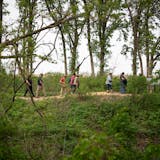Recent testing by the Minnesota Sports Facilities Authority (MSFA) of a bird repellent device at U.S. Bank Stadium ("Audubon group rebuffs bird repellent at stadium," Nov. 18) underscores the need for the MSFA to look no further than its own scientific study to solve the deadly problem of birds colliding with glass at the venue.
The peer-reviewed study, funded by the MSFA and the Minnesota Vikings and released in 2019, found that a significant number of migrating birds are killed by the glass every year, while acknowledging that the true number of fatalities was greater than estimates. Even based on the understated numbers of bird collisions and deaths in the study, the stadium falls in the group of buildings that represent the upper extreme of bird collision rates in the country.
The stadium's highly reflective glass in the Mississippi Flyway, a major migration corridor used by millions of birds twice a year, virtually guaranteed that the stadium would rank among the top bird-killing buildings in Minneapolis. Birds cannot see glass and are killed when they attempt to fly to reflected trees and sky.
The study's conclusions stressed the need to implement mitigation strategies that reduce window collisions using films and visual markers. Audubon Minnesota's final study report identified glass retrofit options that have been tested and approved by the American Bird Conservancy and are endorsed by bird collision experts across the country.
Local examples of effective bird-safe glass treatments include the Bell Museum, Normandale Community College, Bakken Museum, Minnehaha Academy, Minneapolis Central Library, Springbrook Nature Center, Allianz Field and Hennepin County Government Center skyways. Nationally, the U.S. General Services Administration (GSA), which manages federal buildings throughout the U.S., recently announced that beginning in October 2021, all projects must use bird-friendly glass from the ground up to 40 feet.
The product tested by MSFA uses a pesticide to disrupt so-called "nuisance" roosting birds such as pigeons, starlings and grackles by irritating pain receptors in their nervous system. According to the manufacturer, birds must fly through the treated area several times to learn that the vapor is present, which forces them to find a different roosting location. This approach won't deter migratory birds, which are not roosting or nesting, but simply passing through the Mississippi Flyway on their journey to their breeding and nesting locations.
Given concerns raised by Audubon Minnesota about pesticide exposure of people, birds and other wildlife, coupled with the lack of any published scientific research to support the product's effectiveness in reducing bird-window collisions, the MSFA, which owns and operates the stadium, stopped the test.
U.S. Bank Stadium will be here for decades. Thousands more birds will be killed by the glass during that time. And many of those birds will have been prevented from reproducing, further contributing to the documented huge decline of bird populations. The journal Science reported in 2019 that since the 1970s, North America has lost 3 billion birds, or nearly 30% of the total. Among the birds killed at the stadium during the MSFA study were several species found on various conservation watch lists due to declining or threatened populations, which clearly need our protection.
![Three weeks ago, Octavio Rodriguez switched from making transmission parts to casting parts for hospital bed brake assemblies at Twin City Die Castings. ] GLEN STUBBE • glen.stubbe@startribune.com Thursday, April 9, 2020 How employee-owned Twin City Die Casting, which just laid off 40 production workers of its 250 employees in what was supposed to be a good year, is trying to accelerate its pivot to growing medical parts business for ventilators, hospital beds, etc as it copes with instan](https://arc.stimg.co/startribunemedia/WNZYKGTZ5IYMUCO3KI5TR3N7WI.jpg?&w=80&ar=1:1&fit=crop)
djoles@startribune.com As boaters flock to Minnesota lakes and rivers this holiday weekend for the unofficial kick-off to the boating season, they'll face more inspections in and out of the water as local cities and counties ramp up their work to stop the spread of invasive species. Across the metro, more boat accesses will be staffed by watercraft inspectors thanks to $10 million funneled to county government programs this year, up from $4.5 million the state allocated last year. ORG XMIT: MIN1505222156290209 ORG XMIT: MIN1506021218440580](https://arc.stimg.co/startribunemedia/34QSKO44B2XKVNUZCO5SLJQSLY.jpg?&w=80&ar=1:1&fit=crop)

